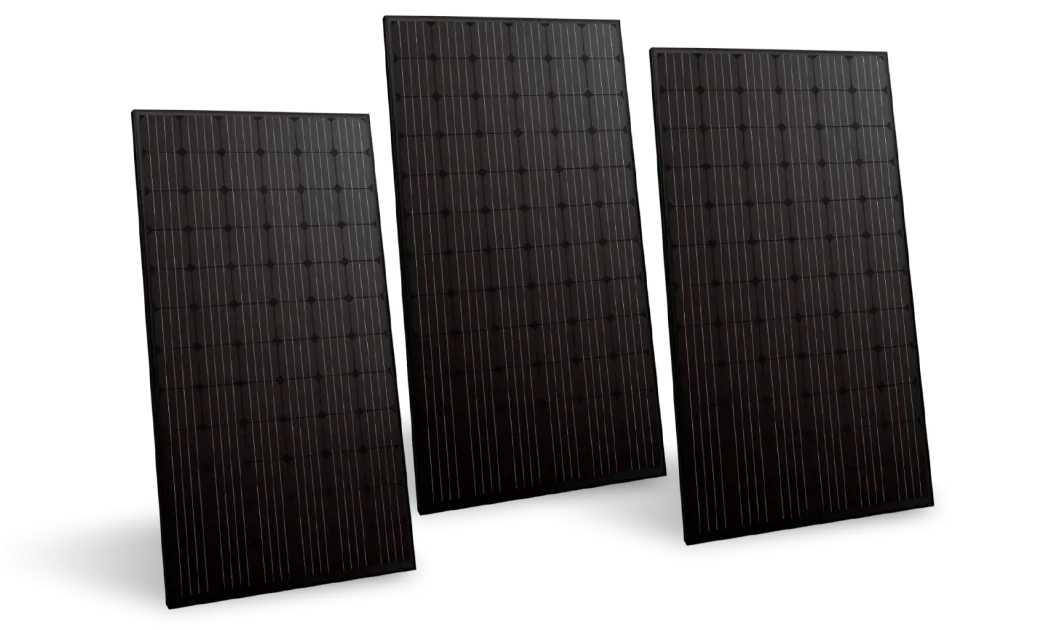- By admin
- 0 Comment
Here are six reasons why bifacial panels are better suited for Florida homeowners.
1. Increased Efficiency. As bifacial modules can produce power from both sides of the panel, energy generation increases overall. Some manufacturers claim that bifacial solar panels can generate up to 30% more energy than conventional monofacial solar panels. This higher efficiency translates into less space per watt, so homeowners can install fewer panels to meet their needs.
2. More Durable. Bifacial panels are frameless and covered on both sides by tempered glass, which makes them often more durable. The tempered glass is weather-resistant and UV-resistant and can withstand high temperatures and strong winds. Because of their durability, bifacial solar panels are expected to have longer lifespans.
3. Aesthetically Pleasing. Bifacial modules come in many designs, including frameless. Many people find the complete glass frame more aesthetically pleasing than monofacial solar panels.
4. Works Well in Diffuse Light. The extra surface area also means that bifacial panels perform better in diffuse light. Making the long-term costs lower than monofacial panels.
5. Reduced PID. In a frameless bifacial panel, the solar cells are less likely to suffer from potential-induced degradation (PID). This is where electrical currents stray from their intended path and, as a result, corrode the solar panels. Furthermore, bifacial panels without a metal frame don’t require grounding, as there are no metal contacts on the exterior.
6. Longer Warranties. Bifacial solar panels often come with a more extended warranty of up to 25 years
Let’s compare a Bifacial panel to 4 of the most often-used monofacial solar panels.
I feel it’s only fair to point out the bifacial panel is equivalent to a 460-watt monofacial panel. All the manufacturers I compared this panel with are trying to catch up with the bifacial design and will have bifacial panels in mid to late 2025.
For my comparisons, I used:
1. Axitec Bi facial- (AXIblackbipremium XXL HC) – 400-Watt Bifacial Solar Panel— German-American-Engineering / produced in Vietnam.
2. REC 405-Watt Alpha Pure– Singapore-made panel.
3. Silfab 400-Watt – Canadian-made panel.
4. Qcell 400-Watt – South Korean-made panel.
5. Tesla 425-Watt- It’s the Q-Cell Solar panel. – South Korean-made panel.
The panels I chose to compare are the most often offered based on price and availability in my home state of Florida.
The STC rating considers the efficiency of the panel’s cells and heat degradation under perfect weather conditions in a warehouse.
The STC is unimportant to Florida homeowners as we need actual weather testing results or NOCT (Nominal Operating Cell Temperature). This information gives you real-world results on your rooftop. The bifacial panels equate to 362 watts using 15% of the STC (400 watts). 15-30% is expected, and we used the least. So take the NOTC rating of 302 for the top side of the panel and add the 15% additional energy creation for the back side, and you get 362 watts or an NOCT rating of 362 watts.
1. Axitec Bifacial 400-Watt = 362-Watts is the usable energy from the panel in real-world conditions.
2. REC Alpha Pure 405-Watt = 309-Watts This is the usable energy from the panel in real-world conditions.
3. Silfab 400-Watt =291-Watts – This is the usable energy from the panel in real-world conditions.
4. Qcell 400-Watt =300.10-Watts – This is the usable energy from the panel in real-world conditions.
5. Tesla 425-Watt- 325.20- watts – This is the usable energy from the panel in real-world conditions.
As you can see, even though they are all rated at or near 400 watts, they are very different in real-world weather conditions, and some of these panels lose a considerable amount of energy vs. the STC rating they were given at the factory.
We need to look at the factory warranties next.
The warranty is divided into three parts.
1. Product Warranty
2. Power Warranty
3. Labor Warranty
Product warranty.
Also known as a material warranty, a solar panel manufacturer’s product warranty covers the integrity of the equipment itself. If your solar panels have a defect or mechanical issue or experience unreasonable wear and tear, that should be covered by your product warranty.
If your solar panel has a defect, it’s typically apparent “out-of-the-box.” In other words, you or your installer should be able to tell that something is amiss and fix the problem immediately–often before the panel even makes it to your roof. Regardless, it’s good to consider products with more extended warranties for the peace of mind they provide.
1. Axitec Bifacial 400-Watt = 25-year material and workmanship
2. REC Alpha Pure 405 watts = 20-year material and workmanship
3. Silfab 400-Watt = 12-year material and workmanship
4. Qcell 400-Watt = 25-year material and workmanship
5. Tesla 425-Watt = 25-year material and workmanship
Power warranty.
Like every other type of electronic, the performance of your solar panels will degrade over time: fortunately, solar panel manufacturers offer a power (or performance) warranty for their products. Power warranties help protect you against atypical degradation of your solar panels, ensuring that the output of your panels won’t fall below a certain level after a set period.
Different types of solar panel technologies degrade at different rates. Generally speaking, the highest quality solar panels offer extended power warranties (25 years or more) that guarantee at least 80 percent of the original output by the end of the warranty term.
1. Axitec Bifacial 400-Watt = 25-year linear performance—85% of 362 watts after 25 years = 307.70 watts. This panel will still generate 307 watts after 25 years.
2. REC Alpha Pure 405 watts = 25-year performance guarantee—85% of 309 Watts after 25 years = 253.65 Watts. This panel will still be generating after 25 years.
3. Silfab 400-Watt = 25-year performance guarantee – 85% of 291 Watts after 25 years = 247.35 Watts. This panel will still be generating after 25 years.
4. Qcell 400-Watt = 25-year linear performance – 85% of 301 Watts after 25 years = 255.85 Watts. This panel will still be generating after 25 years.
5. Tesla-425-Watt = 25-year linear performance – 85% of 325 Watts after 25 years = 276.50 Watts. This panel will still be generating after 25 years.
The Axitec 400-watt bifacial panel delivers more solar watts after 25 years of service than the competitors did when they were first installed brand new.
Labor warranty.
Solar installers are often the sole party responsible for providing a solar installation. However, some manufacturers offer additional protection by adding a labor warranty for a limited number of certified installers in their network.
1. Axitec 400-Watt = 250.00 labor per panel replacement. Panel replacement is paid for by the manufacturer. NOT THE CUSTOMER.
2. REC 405-Watt = No labor per panel replacement. The installer charges the customer.
3. Silfab 400-Watt = No labor per panel replacement. The installer charges the customer.
4. Qcell 400-Watt = No labor per panel replacement. The installer charges the customer.
5. Tesla 425-watt = No labor per panel replacement. The installer charges the customer.
The other factors you may consider when choosing the correct solar panels for your FLORIDA home are as follows:
1. Less is more—The more (NOCT) production you get from the solar panels, the fewer solar panels you need. This means you need less rail to mount them and fewer microinverters. Not to mention that fewer panels and micros equal fewer fault points or better odds of not having a problem.
2. Fewer panels means faster ROI (Return on Investment) and less total cost for the system.
3. Bifacial solar cells may produce more output energy than monofacial solar cells because both sides of the cell, front and rear, can absorb solar radiation. Extra energy production can range from 15% to 30%, depending on the climate.
4. Bifacial panels allow us to mitigate power company restrictions. Tier one in Florida is 28 400-watt panels. By using the bifacial panels, you get more energy production and don’t have to go to a tier-two system. This saves the homeowner a $400-meter fee and a $1 million liability policy cost. Over 25 years, this could save you thousands of dollars in insurance.
You can install the right system in your Florida home if you understand this information.
Don’t take my or anyone’s word without verification—here is where I got the information, and you can verify it all!
This is where all my information came from
NOCT and warranty information were found online in spec sheets.
405 REC Panels https://es-media-prod.s3.amazonaws.com/media/components/panels/spec-sheets/REC400Alpha_Pure_Black.pdf
400 Silfab Panels https://es-media-prod.s3.amazonaws.com/media/components/panels/spec-sheets/Silfab-SIL-400-NU-20210204-Final.pdf
400 Q-Cell Panels https://es-media-prod.s3.amazonaws.com/media/components/panels/spec-sheets/Q_CELLS_Data_sheet_Q.PEAK_DUO_BLK_ML-G10_385-405_2021-05_Rev01_NA_hbNfcin.pdf
425 Tesla Panels https://es-media-prod.s3.amazonaws.com/media/components/panels/spec-sheets/Q_CELLS_Data_sheet_Q.PEAK_DUO_L-G8.2_415-430_2019-07_Rev01_NA_1.PDF
Axitec 400-Watt Bifacial Axitec spec sheet https://es-media-prod.s3.amazonaws.com/media/components/panels/spec-sheets/DB_108zlg_blackbiprem_XXL_HC_CSA_1.pdf
For Axitec, I had to call the manufacturer to get the information. It was not online anywhere.
Here is what he said:
Thank you for our recent call.
The 400W module’s NOCT (Nominal Operating Cell Temperature) is 372 Watts, while its STC (Standard Test Conditions) rating is 400 Watts.
If you have any more questions, you can use the following formula to calculate these values for any panel, given the Temperature Coefficients and nominal operating temperature:
Power rating (STC): 400W
NOCT temperature: 45°C +/-2K
To calculate the power output under NOCT conditions, we can use the power temperature coefficient for output power (Pmpp) -0.35%/K.
1. Determine the temperature difference from STC to NOCT:
NOCT temperature = 45°C +/-2K
Temperature difference = NOCT temperature – STC temperature = 45°C – 25°C = 20°C
2. Calculate the power adjustment based on the temperature coefficient: Power adjustment = Temperature difference * Power temperature coefficient Power adjustment = 20°C * (-0.35%/K)
Power adjustment = -7%
3. Calculate the power output under NOCT conditions:
Power output under NOCT = Power rating (STC) + (Power rating (STC) * Power adjustment)
Power output under NOCT = 400W + (400W * (-7%))
Power output under NOCT ≈ 372W
Thank you for your attention.
Best regards,
Tim Tuttle
National Sales Manager
AXITEC, LLC
510 Pedricktown Road, Suite A
Logan Township, New Jersey 08085 USA

